Self-harm is often misunderstood, it goes beyond physically harming oneself.
Self-harm, also known as self-injury, self-mutilation and non-suicidal self-injury, is a set of behaviors resulting in intentional self-inflicted physical injury to someone’s body. Regarding the physical, psychological and social implications, the topic of self-harm is complex. One person’s desire to intentionally harm their body may seem inexplicable to an outside observer.
By understanding the act of self-harm, the motivators, the styles, and the warning signs, people are better able to recognize and appropriately treat the condition. Self-harm may seem overwhelming, but reliable information and professional treatment can decrease the rates of self-harm and improve the quality of life for many people.
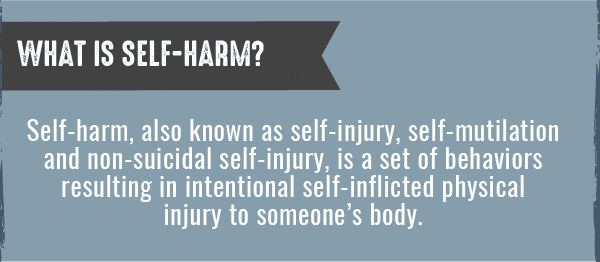
Why Do People Harm Themselves?
Experts view self-harm behaviors as an unhealthy coping skill used to manage intense or uncomfortable feelings. So if someone is feeling very depressed, they may self-harm to control the depressed feelings.
Healthy coping skills like journaling, talking with support networks or listening to music, focus on long-term benefit whereas unhealthy coping skills are built around feeling better immediately. Negative coping skills usually lead to an increase in problems in the future.
Why do people self-harm? Each person will have a unique set of reasons and motivations for injuring themselves, but some common themes include:
- To distract from emotional pain. People with depression or anger may self-harm to shift from emotional to physical pain, which can seem easier to handle.
- To release tension. Someone with high stress or anxiety may self-injure to reduce these feelings.
- To feel something. Some people express feeling numb and through self-harming, they create a feeling.
- To express themselves. As a way to stand out or change their body, self-harm can be a form of self-expression.
- To self-punish. If someone feels they failed in some way, they may self-harm as a punishment for their actions.
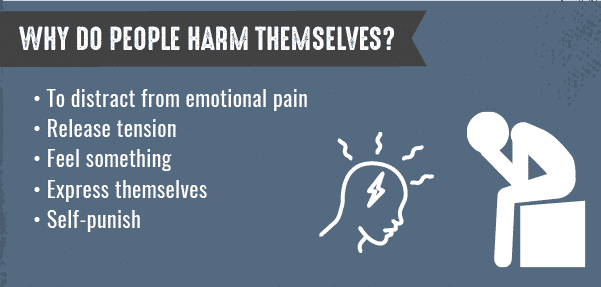
Forms of Self-Injury
There are several reasons why people self-harm and consequently, there are many types of self-harm. Some people may only engage in one type while others might experiment with each variation depending on the situation and their desired goals.
Some common types of self-injury include the following:
Cutting
Cutting is one of the most common types of self-harm and involves using an object like a knife or razor blade to damage the skin. Some cutting may be superficial and not break the skin. Other cutting could pass through the surface and draw blood before entering into layers of muscle and fat.
“Carving” is a type of cutting that involves slicing pictures, designs or words into the skin so a resulting scar will maintain the shape. Rather than making long cuts across the surface of the skin, some people may poke or puncture through the skin to self-injure.
Hitting Oneself
People also self-harm by hitting themselves or having other people hit them. This group may punch, bite or kick themselves. This type of self-harm can also include someone hitting their head or other body parts against walls or doors. Typically, the goal is to leave a lasting bruise.
Although males are less likely than females to self-injure, they are more likely than females to engage in hitting as their preferred form of self-harm.
Pulling Hair
Pulling hair is another type of self-harm. During this process, people will pluck single hairs or clumps of hair from their head, eyebrows, eyelashes, arms, legs or pubic area with the intention of feeling pain.
Hair pulling for the purpose of self-harm is especially complicated because symptoms of other mental health conditions involve hair pulling. Trichotillomania, also referred to as hair-pulling disorder, involves people pulling out their hair so much it results in hair loss. A potential difference is people with hair-pulling disorder do not want to pull hair, it is a compulsive behavior. Hair pulling could be self-harm or a sign of something more.
Scratching
Scratching shares similarities with cutting but instead of using a sharp object, the person uses their fingernails to self-harm. Like hair pulling and trichotillomania, a mental health disorder called excoriation (skin-picking disorder) involves scratching and picking at skin. Scratching could be self-harm exclusively, or part of the compulsive skin-picking disorder.
Interfering with Healing of Injury
People may engage in self-harm through delaying and prolonging the healing process. Someone can avoid medical attention for illnesses as a passive form of self-injury, or they can actively pick at scabs or previously injured areas. Both actions result in increased pain and healing time.
Burning
Using matches, lighters, lit cigarettes, candles and other hot surfaces, some people will self-harm through burning. The self-injury process may be very short or drawn out over a long period.
Choking or Suffocating
Either with their hands, or with something around their neck or over their whole head, choking and cutting off oxygen is another type of self-harm. Not every choking incident is necessarily intended as self-harm. Choking oneself has become a game where adolescents and young adults challenge each other to choke themselves or have another choke them until they pass out. Rather than trying to achieve pain, participants hope to feel a brief euphoric state due to lack of oxygen.
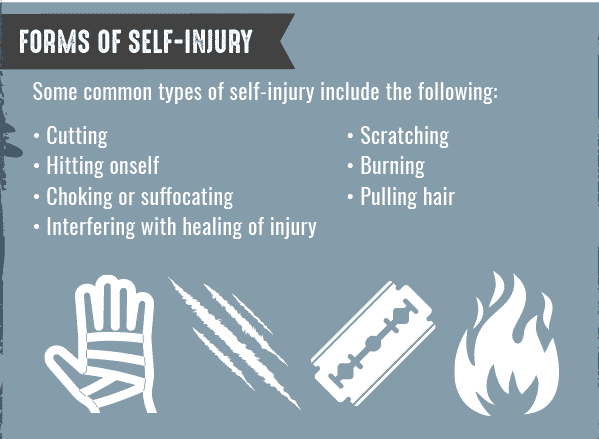
Warning Signs of Self-Harm
Because there is a stigma surrounding self-harm, identifying people engaging in these behaviors can be challenging. If you are worried a loved one is hurting themselves, it’s essential to know how to recognize the warning signs of self-harm.
Behavioral Signs
Behavioral warning signs of self-harm include changes in someone’s actions like:
- Low mood/ tearfulness
- Low motivation
- Loss of interest in pleasurable activities
- Isolation
- Staying out all night
- Spending time with a new group of friends
- Talking about death
- Keeping secrets or changing their normal communication style
- Sleeping too much or too little
Physical Signs
The physical signs are usually identified in someone’s appearance. Be sure to pay attention to:
- Wearing multiple bandages
- Reluctance to show parts of the body
- Any new, unexplained injuries or any old wounds that are not healing well
- Wearing long sleeves and long pants all year long
- Gaining or losing a lot of weight
- Hair loss anywhere on the body
Other Signs
Someone engaging in or thinking about self-harm could display several other warning signs. Additional warning signs may include:
- Spending excessive time researching self-injury online
- Buying a variety of blades
- Stockpiling knives or razors in their rooms
- Hiding bloody rags in the garbage
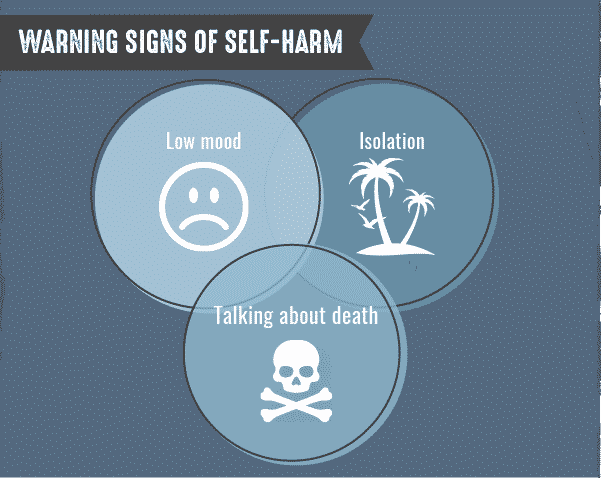
Non-Suicidal Self-Injury
While informing yourself on the topic of self-harm, you are likely to come across the term non-suicidal self-injury (NSSI). The term NSSI is used to encompass a group of self-harm behaviors that are not intended to result in death. It can be confusing to think self-harm is anything other than a suicidal act, but most people who self-harm are seeking a way to improve their life – not end it.
There is an overlap between NSSI and self-injury with suicidal intent. People who self-injure are more likely than the general population to think about or attempt suicide.
Self-Harm Statistics
Self-harm is a prevalent and multifaceted problem. The American Psychological Association reports:
- About 15 percent of college students have harmed themselves at least once
- About 17 percent of adolescents have self-harmed
- Young white females are the group most likely to self-harm
- Males represent between 35 and 50 percent of all people who self-harm
- Being a sexual minority increases the likelihood of engaging in self-harm
Although people may assume white, middle-class females are the only group who self-harm, people engage in the act regardless of gender, race, ethnicity, sexual orientation and socio-economic status, according to the Cornell Research Program on Self-Injury and Recovery.
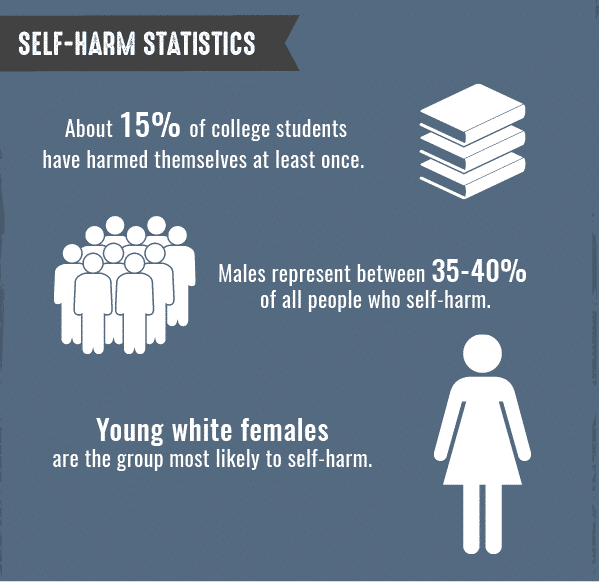
Causes of Self-Harm
No one factor causes self-harm. Instead, self-harm is a problem with multiple contributors. Each person’s contributors will be unique to their situation. Some possible causes of self-harm include the following:
- Substance Abuse. Self-harm and substance abuse are strongly connected. It appears that people who misuse alcohol and other drugs are more likely to self-harm than those people who do not. This relationship could be due to the lack of self-control and poor judgment caused by substance intoxication.
- Mental Illness. Self-injury is more common among people with mental health conditions than in people without mental health issues. If someone has depression, borderline personality disorder, anxiety or eating disorders, they have a greater chance of self-injury. People living with mental health disorders may need treatment specifically for self-harm and mental illness.
- Trauma. Lack of comfort and life stability can contribute to self-harm and trauma. Like other conditions affecting someone’s mental health, traumatic life events like abuse, neglect, the threat of violence and loss add to the likelihood of self-harm.
- Outside Influence. Other people may self-harm just because they overhear their peers talking about the experience or they see self-injury carried out in the media. These outside influences may spark curiosity in self-harm, which may lead to someone engaging in the act.
Effects of Self-Harm
The effects of self-harm differ between people based on various individual differences including their available support network and stressors. Self-harm makes the emotional or physical pain experienced by the individual worse over time. Someone who self-injures may feel better briefly, but the relief is often replaced with shame and guilt, which can lead to more self-injury. This cycle is dangerous and can end with increased self-harm and a loss of positive coping skills.
People engaging in self-harm may struggle with school or job performance and they may lose healthy relationships. Self-harm can negatively influence every part of a person’s physical, mental and social well-being.
Suicide and Self Harm
Suicide and self-harm share many similarities, but self-harm is not always intended to be a suicidal attempt. Evidence shows that most people who self-injure (about 60 percent) never consider attempting suicide of self-harm.
Self-harm can quickly and accidentally escalate, though. An episode of misguided cutting or choking can end with death. Family, friends and professionals should take all self-harm seriously because it can lead to suicidal thoughts and attempts in the future.
Getting Help for Self-Harm
Feelings of shame and guilt can make someone think that self-harm help is inaccessible. The truth is that many people are ready to help a person struggling with self-injury. Professional self-harm treatment is performed by a number of qualified experts including:
- Counselors/ social workers
- Psychologists
- Psychiatrists
- Primary care doctors
These professionals may employ a combination of therapy and medications to reduce symptoms and promote recovery while addressing underlying causes. Bringing up the topic of self-harm to a professional may be uncomfortable, but the benefits of treatment can outweigh the discomfort.
Those people who are interested in a more discreet and anonymous first step towards self-harm help could consider calling a hotline like the National Suicide Prevention Lifeline at 1-800-273-TALK.
How to Help a Loved One
Deciding how to help someone with self-harm triggers feelings of uncertainty. If your loved one is showing the warning signs of self-harm, express your concern from a kind and loving position. Never yell, shame or threaten your loved one. These actions may only increase the problem.
Let your loved one know you care about them and think they would benefit from seeking professional help from an expert. You can also encourage them to talk to a teacher or a trusted adult. Unless you are an expert who knows how to help someone with self-harm issues, refer your loved one to a mental health professional.
Self-Harm Prevention
Prevention is a beneficial tool when addressing self-harm. Self-harm prevention methods include:
- Understanding the warning signs and risk factors
- Identifying those at high risk and connecting them to treatment
- Raising awareness in the community
- Increasing open communication about difficult issues
- Helping people expand their social networks
- Removing the stigma around the condition to reduce shame and guilt
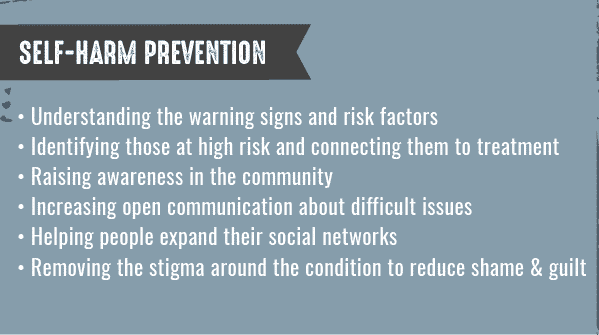
Having issues with self-harm, substance use disorders or mental health conditions may seem overwhelming, but experts are available to assist with these problems and begin a path to recovery. If you are struggling with a substance use and co-occurring mental health disorder like self-harm, consider contacting The Recovery Village and speak with a representative to learn more about treatment options that could work for you.


American Psychiatric Association. “Diagnostic and Statistical Manual of Mental Disorders – Fifth Edition.” 2013.
American Psychological Association. “Who Self-Injures?” July/ August 2015. Accessed on January 5, 2019.
Cornell Research Program on Self-Injury and Recovery. “What is Self-Injury?” 2010. Accessed on January 9, 2019.
MentalHealth.gov. “Self-Harm.” August 22, 2017. Accessed January 5, 2019.
National Alliance on Mental Illness. “Self-Harm.” No date. Accessed January 5, 2019.
National Health Services – UK. “Self-Harm: Overview.” May 25, 2018. Accessed on January 9, 2019.
National Institute on Drug Abuse. “Drugs, Brains, and Behavior: The Science of Addiction.” July 2018. Accessed January 5, 2019.
National Institute on Drug Abuse. “Principles of Drug Addiction Treatment: A Research-Based Guide.” January 2018. Accessed January 10, 2019.
National Institutes of Health. “Hurtful Emotions: Understanding Self-Harm.” September 2017. Accessed January 5, 2019.
Time.com. “Kids are Playing the ‘Choking Game’ […]ad, They’re Dying.” March 12, 2018. Accessed January 9, 2019.
The Recovery Village aims to improve the quality of life for people struggling with substance use or mental health disorder with fact-based content about the nature of behavioral health conditions, treatment options and their related outcomes. We publish material that is researched, cited, edited and reviewed by licensed medical professionals. The information we provide is not intended to be a substitute for professional medical advice, diagnosis or treatment. It should not be used in place of the advice of your physician or other qualified healthcare providers.